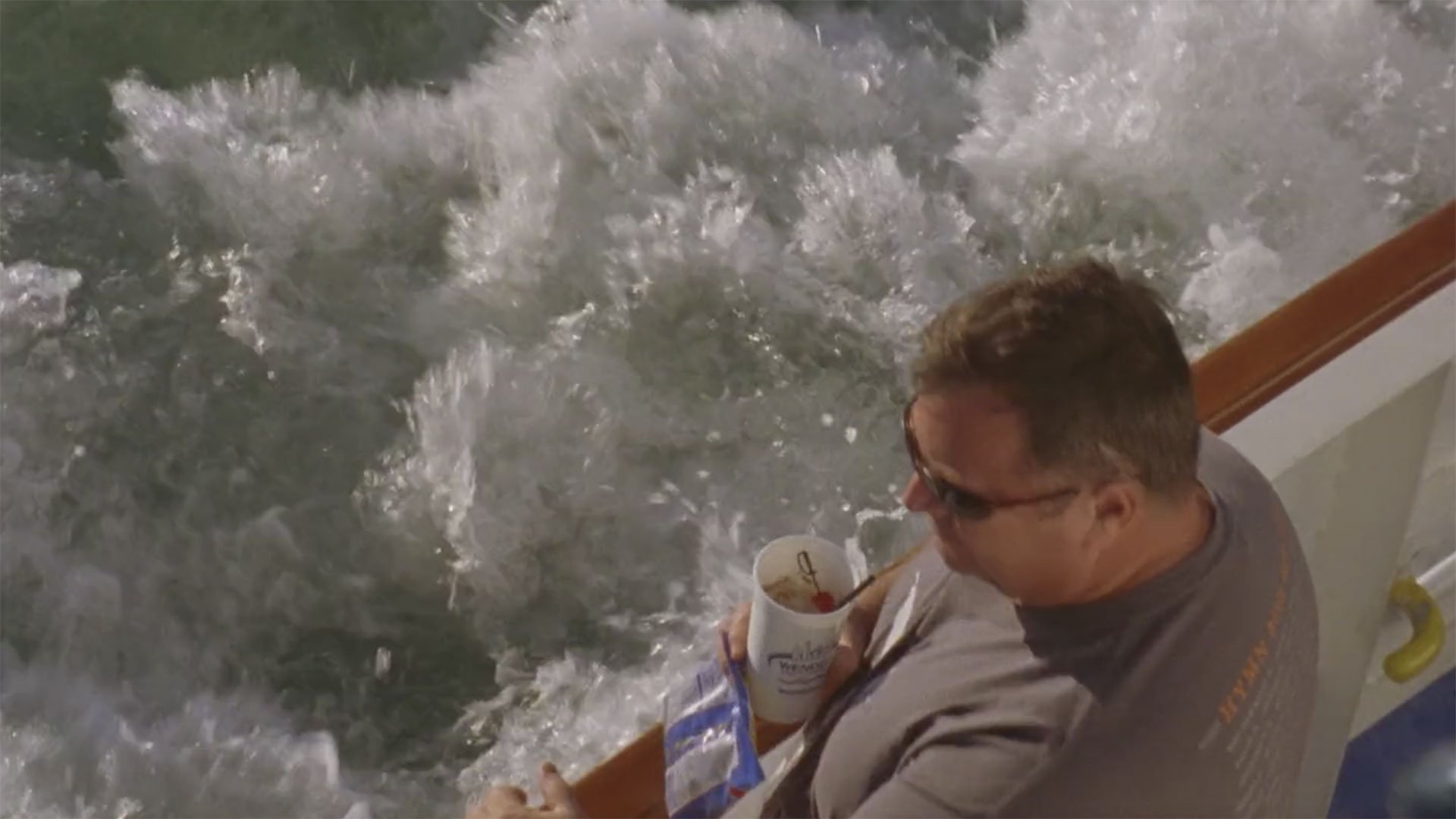At this year’s edition of the excellent experimental documentary festival Prismatic Ground artist Christopher Harris was the recipient of the 'Ground Glass Award. In celebration, several of Harris’ works were screened online for the festival’s duration.
Dreams Under Confinement (Christopher Harris, 2021)
In an interview for Tone Glow, the filmmaker Christopher Harris elucidated how his work sets out to rattle and fracture the assumption that there is only one reality, a notion he calls ‘pure ideology’, by bringing up his affinity with the Ancient Greek conception of how the eye functions. It is a theory that has been scientifically debunked, but remains metaphorically astute. Instead of the eye as a receptacle, receiving light and then feeding it to the brain, they figured what we see is not a reflection but a projection. The world literally issued forth from the act of looking.
Harris has multifarious ways of unpacking and recreating the world, or more specifically, the American state and conceptions of race. These could all be discovered in a near-complete, online retrospective of his work during the 2022 edition of Prismatic Ground, a New York based festival dedicated to experimental documentary, who awarded Harris this year’s Ground Glass award. This is Harris’s second outing with the festival, for a new digital restoration of his 2004 film Reckless Eyeballing debuted during the first edition, and has returned for this retrospective.
Reckless Eyeballing is a powerful evocation of ‘looking’ and ‘being looked at’ as a racially charged zone of control and creation - as suggested by its title, a term which during slavery referred to the perceived ‘insubordinate’ act of a black person making eye contact with a white person of authority. Under Jim Crow laws, it was the punishable offence of a black man looking ‘lustily’ at a white woman. Working with reprinted, black and white 16mm, Harris rhythmically cycles through, lacing and unpacking three figures: Gus, a black union soldier from The Birth of a Nation (1915), played by white actor Walter Long in blackface; Pam Grier in the eponymous, iconic role of Foxy Brown (1974); and footage of intellectual and activist Angela Davis. In other words, three different representations of blackness; the first a white supremacist, distorted mockery, the second an image of black feminine empowerment and also objectification, and in third, as the symbol of a more confident and defiant, collective expression.
Reckless Eyeballing (Christopher Harris, 2004)
In putting these very different images and implications in concert, Harris is highlighting blackness, and the power structures defining it, as constructed, therefore as potentially alterable. He expresses this through a constant framing of these images as malleable entities. The fabric of the film is constantly distorted, sometimes bulging out, impressing on us to grasp them, and near the end, he switches to photo negative, turning black to white. The sound is also in the same state of flux, marked by the haptic rustling of the format and certain looped passages, both spoken and musical. The most prominent, and haunting, is the repeated, abrupt phrase, ‘She will never look’. It seems to express a stifled autonomy, a choking inability to define the self or the world. Yet a certain ambiguity in its emphasis, and the intensity of Grier’s stare, seems to portray the mantra, and the film, as a positive challenge. She will never look but she should, so should we all.
Reckless Eyeballing is also the title of a 1986 novel by Ishmael Reed, one of literature’s foremost conveyer of the black American experience in a medley of mish-mashed and satiric forms. His work is a major touchstone for Harris, to the degree that he has been working for many years on Speaking in Tongues, a loose adaptation of Reed’s most acclaimed novel, Mumbo Jumbo (1972). That book is often tied into the loose and bountiful aesthetic and philosophical web known as Afrofuturism, which Harris surely has a part in. Science fiction interlopes upon, and reflects, the mundane in several of his works, with cosmological postulations scoring a Floridian poolside haze in Sunshine State (Extended Forecast) (2007) and a boat ride up the Chicago river in Distant Shores (2016).
28.IV.81 (Bedouin Spark) (2009) would seem like one of Harris’s more modest works. Indeed, it’s an outlier in the sense that it was a spur of the moment creation, with Harris suddenly taken by the notion to film his kids’ nightlight. In addition to its conciseness, it is also an ingenious testament to humanity’s ability to imagine. The cosmos may hang obscurely over the two previously mentioned films, but here lightyears can be condensed into miniature form, for a child’s pleasure and enlightenment. Its secret complexity, in the shape of freeform, circuitously swirling patterns, is revealed by Harris’s intent gaze and accentuated by his intricate cutting.
Distant Shores (Christopher Harris, 2016)
Dreams Under Confinement (2021) is Harris’s latest and, like his first and longest film still/here (2001), which was not screened, it’s an exegesis of the urban experience and its physical and politicized topography. It also marks a significant change-up in his toolkit, as a digital work following a corpus that was entirely shot on film, making ample use of its particularities. Dreams Under Confinement is not only digital but presents what may be perceived, initially, as a cold and virtual view, as it takes place entirely within a Google Earth simulacrum of Chicago—a choice made partly out of necessity, due to the restrictions of the pandemic. However, within its 3 jam-packed minutes, Harris will make this imposed form burn with formal possibilities and insurrection.
It begins at a point of relative stability, with the camera hovering directly over a fairly uniform and homogenous slice of the city which the cursor identifies as Cook County Jail. All the while we hear the cacophonic recording of a 911 dispatcher. Once the jail, this imposing node of power, has been demarcated, the movie slingshots, exploding in every direction. Harris speedily tracks back and forth across the city, using the cursor-camera to disrupt the established aerial, 2D view of the city—an architectonic, surveillance perspective, and therefore one of control—by gesturing in and out, in 3D, with quick, whipping and stabbing camera movements. Like an agile swordsman, slicing up this top-down view, and disrupting, literally and symbolically, by incrementally going from the top, down to street level where the mad dash continues.
His camera movements operate in conjunction with the soundtrack, which metastasizes from one dispatch call to many, joined by other police recordings and sirens in an overlapping barrage of complex rhythms. It’s a congealed fissure of mass violence. The desperate acts of rebellion from the city’s oppressed populace become entangled with more tactical, racialized violence perpetrated by the long arm of the law. The true seat of power is not City Hall, or even the courts, but the prison, as Harris ends the film by looping back to the jail. However, it’s not like the beginning, with its view of the city as a secure, totalitarian dream, scrubbed of the unmanageable hubbub of the masses. Harris has not only refuted this view but has traced an exponential, auditory trail of oppression back to the centre of this caracal state. His unbounded digi-camera skills, combined with his musical sense, also bestows a new, de-hierarchised way of representing the city, power, race, and - therefore - living.
Prismatic Ground ran both physically at New York’s Maysles Documentary Centre and online from 4-8 May 2021.
Ruairí McCann is a Belfast born and based writer, raised in Sligo. He sits on the board of the Spilt Milk Music & Arts Festival, has written and edited for Ultra Dogme, photogénie and Electric Ghost, and is a contributor for MUBI Notebook, Screen Slate and Sight & Sound.



